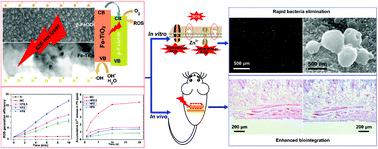当前位置:
X-MOL 学术
›
Biomater. Sci.
›
论文详情
Our official English website, www.x-mol.net, welcomes your
feedback! (Note: you will need to create a separate account there.)
β-FeOOH/Fe-TiO2 heterojunctions on Ti for bacteria inactivation under light irradiation and biosealing
Biomaterials Science ( IF 5.8 ) Pub Date : 2020-09-15 , DOI: 10.1039/d0bm01290d Kai Li 1, 2, 3, 4 , Yang Xue 1, 2, 3, 4 , Lan Zhang 1, 2, 3, 4 , Yong Han 1, 2, 3, 4
Biomaterials Science ( IF 5.8 ) Pub Date : 2020-09-15 , DOI: 10.1039/d0bm01290d Kai Li 1, 2, 3, 4 , Yang Xue 1, 2, 3, 4 , Lan Zhang 1, 2, 3, 4 , Yong Han 1, 2, 3, 4
Affiliation

|
Intraosseous transcutaneous implants transferring mechanical stress directly from the skeleton to a prosthesis are an area of biological mechanics. However, bacterial invasion and weak biosealing with skin tissue usually induce implant failure. In this paper, composite coatings consisting of β-FeOOH as an outer layer and Fe-TiO2 as an inner layer were prepared on Ti via micro-arc oxidation and hydrothermal treatment (HT). The surface microstructures and optical absorption properties of the coatings were observed, the production of reactive oxygen species (ROS) was measured, Staphylococcus aureus (S. aureus) and fibroblast behaviors were studied in vitro, and bacteria inactivation and skin tissue responses on different surfaces were evaluated in vivo. The results show that Fe3+ was doped into TiO2 and β-FeOOH nanoparticles were gradually deposited on TiO2 during HT treatment, forming β-FeOOH/Fe-TiO2 heterojunctions. The light absorption of the composite coatings shifted to the longer wavelength region because of a narrowed TiO2 bandgap and the formation of heterojunctions. Under light irradiation, photoinduced electrons and holes on the heterojunctions were separated efficiently. Via optimizing the amount of Fe3+ in TiO2, ROS that formed at the heterojunctions after light irradiation for 10 min could kill 80% of S. aureus compared with pure Ti in vitro, but they did not affect fibroblast behavior, including proliferation and phenotyping. In vivo, the optimized β-FeOOH/Fe-TiO2 heterojunctions, upon light irradiation, could inhibit bacterial infection, suppress an inflammatory response, and promote integration with skin tissue. Such results provide a new perspective suggesting the potential application of β-FeOOH/Fe-TiO2 heterojunctions in percutaneous Ti implants, especially in infected cases.
中文翻译:

钛上的β-FeOOH/ Fe-TiO2异质结在光照射和生物密封作用下灭活细菌
骨内经皮植入物将机械应力直接从骨骼转移到假体,是生物力学领域。但是,细菌入侵和与皮肤组织的弱生物密封通常会导致植入物失效。本文通过微弧氧化和水热处理(HT)在Ti上制备了以β-FeOOH为外层和Fe-TiO 2为内层的复合涂层。观察了涂层的表面微观结构和光吸收性能,测量了活性氧(ROS)的产生,金黄色葡萄球菌(S. aureus)和成纤维细胞的体外行为,和细菌灭活和皮肤组织反应的不同表面进行了体内评估。结果表明,在HT处理过程中,Fe 3+被掺杂到TiO 2中,β-FeOOH纳米颗粒逐渐沉积在TiO 2上,形成β-FeOOH/ Fe-TiO 2异质结。由于TiO 2带隙变窄和异质结的形成,复合涂层的光吸收转移到了更长的波长区域。在光照射下,异质结上的光致电子和空穴被有效分离。通过优化TiO 2中Fe 3+的含量,在体外照射10分钟后,在异质结处形成的ROS可以杀死80%的金黄色葡萄球菌,而不是纯Ti ,但它们不影响成纤维细胞的行为,包括增殖和表型。在体内,经过优化的β-FeOOH/ Fe-TiO 2异质结在光照下可以抑制细菌感染,抑制炎症反应,并促进与皮肤组织的融合。这些结果提供了一个新的观点,暗示了β-FeOOH/ Fe-TiO 2异质结在经皮Ti植入物中的潜在应用,尤其是在感染病例中。
更新日期:2020-09-30
中文翻译:

钛上的β-FeOOH/ Fe-TiO2异质结在光照射和生物密封作用下灭活细菌
骨内经皮植入物将机械应力直接从骨骼转移到假体,是生物力学领域。但是,细菌入侵和与皮肤组织的弱生物密封通常会导致植入物失效。本文通过微弧氧化和水热处理(HT)在Ti上制备了以β-FeOOH为外层和Fe-TiO 2为内层的复合涂层。观察了涂层的表面微观结构和光吸收性能,测量了活性氧(ROS)的产生,金黄色葡萄球菌(S. aureus)和成纤维细胞的体外行为,和细菌灭活和皮肤组织反应的不同表面进行了体内评估。结果表明,在HT处理过程中,Fe 3+被掺杂到TiO 2中,β-FeOOH纳米颗粒逐渐沉积在TiO 2上,形成β-FeOOH/ Fe-TiO 2异质结。由于TiO 2带隙变窄和异质结的形成,复合涂层的光吸收转移到了更长的波长区域。在光照射下,异质结上的光致电子和空穴被有效分离。通过优化TiO 2中Fe 3+的含量,在体外照射10分钟后,在异质结处形成的ROS可以杀死80%的金黄色葡萄球菌,而不是纯Ti ,但它们不影响成纤维细胞的行为,包括增殖和表型。在体内,经过优化的β-FeOOH/ Fe-TiO 2异质结在光照下可以抑制细菌感染,抑制炎症反应,并促进与皮肤组织的融合。这些结果提供了一个新的观点,暗示了β-FeOOH/ Fe-TiO 2异质结在经皮Ti植入物中的潜在应用,尤其是在感染病例中。











































 京公网安备 11010802027423号
京公网安备 11010802027423号